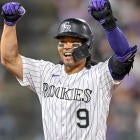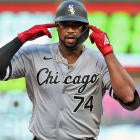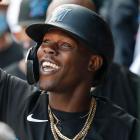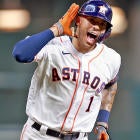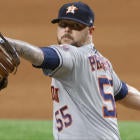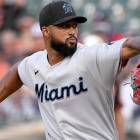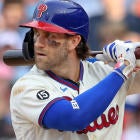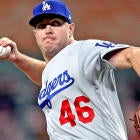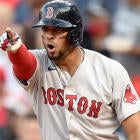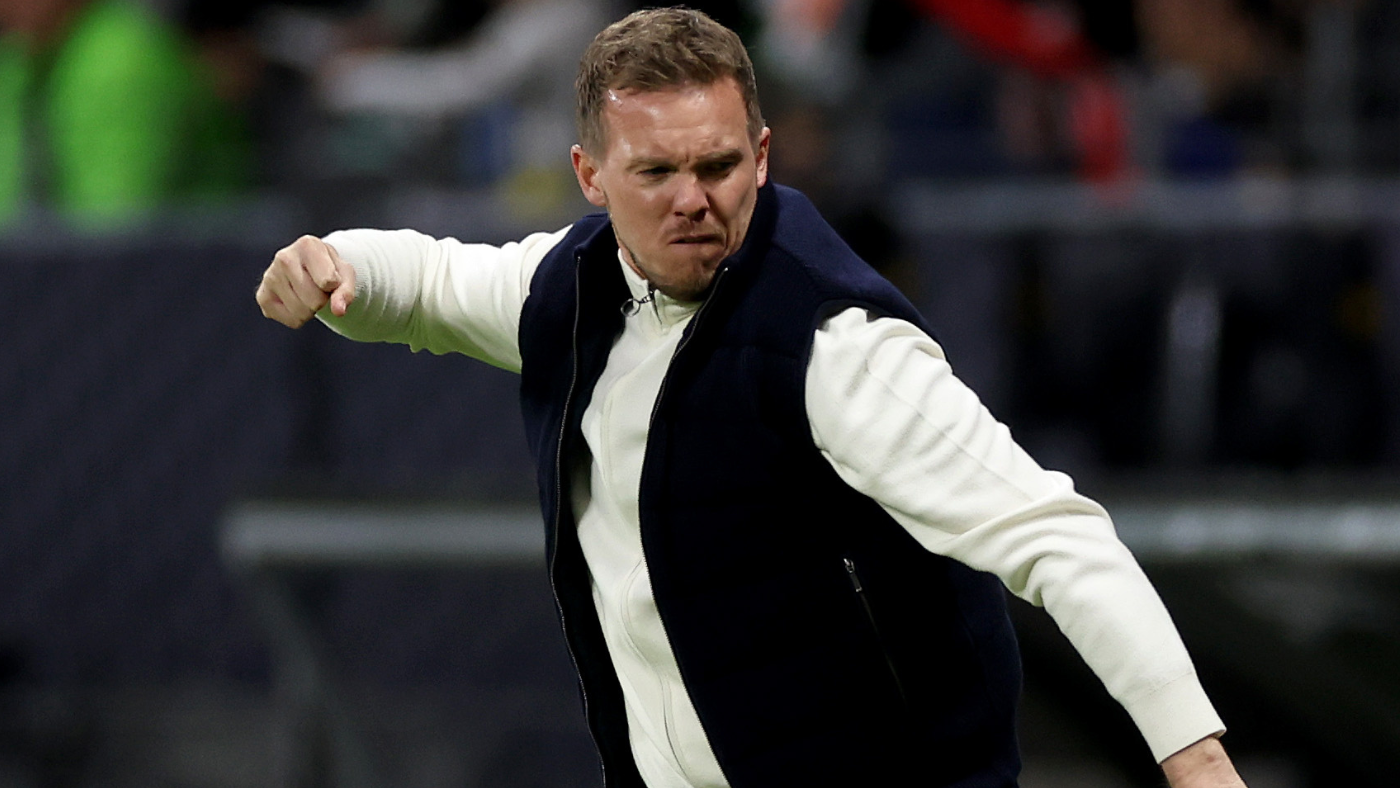
Welcome back. So nice to see you again. How long has it been? Couple months, you say, but I know better. No need to spare my feelings. Just admit it: You checked out as soon as Fantasy Football started.
Maybe it wasn’t even anything so deliberate. Maybe you fell out of contention in your Fantasy Baseball league and simply lost interest. It happens.
But, um … you missed a lot, things that might catch you by surprise as you begin your preparations for 2022.
I’m here to catch you up, to fill you in on the biggest developments and the impact they had on the landscape. Buckle up, because it’s a wild ride.
Notable newcomers
- You may remember Phillies ground-ball specialist Ranger Suarez was beginning a successful transition to the starting rotation, but he just kept getting better the more he was stretched out, going six-plus innings his final five starts and even throwing a complete game shutout his second-to-last time out. In all, he had a 1.36 ERA, including 1.51 in 12 starts.
- Career minor-leaguer Frank Schwindel may have seemed destined to come down to earth, a la Yermin Mercedes, after his impossibly hot start as the Cubs first baseman, but he ended up hitting .344 with seven homers and a .988 OPS in September compared to .344 with six homers and a 1.030 OPS in August. He isn’t being drafted like a top-15 first baseman, but perhaps he should be.
- Daulton Varsho actually began to heat up in July and August, but his numbers were so bogged down at that point that you may have overlooked it. In all, he hit .290 with 10 homers, five steals and an .879 OPS in the second half. With his ability to pick up extra at-bats in the outfield, he’s looking like a trendy catcher pick.
- Nicky Lopez went from being a black hole in the Royals lineup to everything we hoped the White Sox’s Nick Madrigal would be coming into the year. It started in June, but because he was batting .227 at the time, it took four months to bring his season batting average up to .300. He also had 22 steals in 23 attempts. There’s no power to speak of, but Lopez would appear to have a place in Fantasy as a two-category specialist.
- Giovanny Gallegos moved back into the closer role with Alex Reyes shifting to long relief in anticipation of joining the starting rotation next year. Gallegos has been the Cardinals‘ best reliever for the past few years and was so reliable during Cardinals’ 17-game winning streak (oh yeah, that happened), saving eight of those wins, that he’s in position for the role this year, too.
- An oblique injury for Jake McGee, mild though it was, opened the door for Gabe Kapler to experiment with the closer role, and he quickly settled on Camilo Doval, a rookie who rejoined the team at the start of September and brought the gas at 102 mph. He only got three saves but secured them in such dominant fashion that he looks like the favorite going into 2022.
Concerning developments
- Clayton Kershaw, who already took two months to recover from a bum elbow, aggravated the injury in his final regular season start (only his fourth back) and was ruled out for the entire postseason. An MRI revealed no ligament damage, but in recurring cases like his, that’s not always the end of it. Already no stranger to the IL, the 34-year-old Kershaw isn’t being drafted with the usual gusto this year.
- There weren’t a lot of details surrounding Carlos Rodon’s dramatic drop in velocity (we’re talking upward of 3 mph) and infrequent use in September. Manager Tony La Russa made reference to some physical issue, which Rodon downplayed. The left-hander did miss a stretch in August due to shoulder fatigue but looked pretty OK in his first start back before faltering later. Or maybe falter isn’t the right word. After all, he still put together a 2.00 ERA, 0.89 WHIP and 11.0 K/9 in four September starts, short though they were. He hasn’t signed yet, but the terms of the contract he eventually receives will give us a better idea how concerned we should be.
- Mike Trout never did end up returning from his May calf strain, which was surprising. Jacob deGrom, despite a frantic buildup late in the year, never made it back from a sore elbow, which was less so. Trout will have had nine months to recover by the time the new season starts, so there shouldn’t be any lingering concerns for him, but deGrom is another matter. President Sandy Alderson actually confirmed there was a UCL tear at one point, but the MRI isn’t showing it anymore. Clearly, we’ll need some assurances this spring before we sink a first-round pick into deGrom, as good as he is.
- Gerrit Cole was among the pitchers who suffered the biggest drop in spin rate during the foreign substance crackdown that began in June. That rate soon corrected, though, and he remained among the best strikeout pitchers in the game. Still, he had a 4.14 ERA in the second half, and his poor showing in the wild card playoff against the Red Sox has left a bad taste in everyone’s mouth. It was, however, the last of a bumpy four-start stretch that began with him suffering a hamstring injury, which may have had more to do with his struggles than anything else. He was on a nice run before then.
Even better than you think
- Juan Soto’s overall numbers are great and all, but would you believe he reached base at a .525 clip in the second half? Yup, he got on more than he got out, thanks in large part to his 87 walks compared to just 41 strikeouts during that stretch. In fact, it’s fair to say that with his .471 OBP between 2020 and 2021, Soto is the best on-base guy we’ve seen since Barry Bonds himself.
- Paul Goldschmidt used to be a first-round staple in Fantasy Baseball, and for the final four months of 2021, he played like one, batting .322 with 25 homers, nine steals and a .978 OPS. That’s a full two-thirds of the season, so maybe you noticed it before checking out for the year. But the best of those months were August and September, during which he hit .340 with a 1.050 OPS. Not bad for a 34-year-old presumed to be on the decline.
- Perhaps you’re aware Bryce Harper put together his best season since his MVP-winning 2015, punctuated by his .330 batting average, 19 homers and 1.194 OPS over the final two months. It goes beyond that, though. Take out the month of May, when he was still dealing with the aftereffects of a gnarly hit by pitch, and his overall stat line becomes a .323 batting average, 34 homers, 11 steals and 1.097 OPS.
- Of the 48 home runs Salvador Perez hit, setting the record for most by a player who spent the majority of his time at catcher, 22 came in the final two months. He also tied Vladimir Guerrero for the major-league home run lead, and his 121 RBI led the majors outright. We haven’t seen a season like that at the position since Johnny Bench.
- Frankie Montas finished the year with a respectable 13-9 record, 3.37 ERA, 1.18 WHIP and 10.0 K/9, once again positioning himself as a high-end Fantasy hurler after slipping off that perch in 2020. But the final line undermines just how dominant he was down the stretch, compiling a 2.11 ERA, 1.02 WHIP and 10.8 K/9, complete with a 15.9 percent swinging-strike rate that would have equaled Max Scherzer if he had maintained it all season. The key for Montas, as during his breakout 2019, was his splitter, which he began featuring more than ever during that stretch.
- Kyle Tucker hit like mush in April, as so much of the league did, which makes his final line all the more impressive. From May 1 on, the 24-year-old hit .320 with 25 homers, 12 steals and a .986 OPS. He hit .346 with eight homers and a 1.130 OPS in September alone.
- If you’re like me, you presumed Marcus Semien’s production would drop off eventually given that he was outperforming his expected stats from the get-go, but it turns out he saved his best for last, hitting 13 of his 45 home runs in September. Confidence in him appears to be at an all-time high, even following his move to the Rangers. I’ll point out that he did hit the majority of his home runs on the road this year.
- In his first year as a full-time starter for an organization known for playing it safe with young arms, Julio Urias was, naturally, the majors’ only 20-game winner. What you may not realize is the kind of run he went on to get there, putting together a 1.71 ERA over his final 13 starts.
- Having already turned his season around after a shoulder injury knocked him off track early, Max Fried found another gear in August, putting together a 1.46 ERA to close out the season. He went six innings or more in all 11 of those starts and threw two shutouts. As unsustainable as his 2.25 ERA seemed during the pandemic-shortened 2020, his 2021 ERA drops to 2.44 if you remove his three April starts — when, again, he was afflicted by a shoulder injury.
- Tyler O’Neill is sure to inspire some double-takes when people see how early he’s going, but a late push clearly moved him into stud territory. He hit .328 with 13 homers, five steals and a 1.108 OPS in September after also batting over .300 in August to give him, in all, a .286 batting average, 34 homers, 15 steals and .912 OPS.
- Brandon Belt equaled his previous career high in home runs (18) just from Aug. 6 on, giving him a total of 29 in only 97 games. Project that over 150 games, and he’s closing in on 45. He broke through with stud numbers in 2020 as well, buoyed in large part by Oracle Park playing more fairly for hitters, but of course, nobody believed it given the nature of 2020. Well, do you believe it now?
Partial redemptions
- Losing 2 1/2 months to a fractured hand didn’t help, but the bottom line is that Corey Seager didn’t live up to his 2020 breakout, the one that got him drafted in the second round in most leagues. A big September in which he hit .385 with nine homers and a 1.174 OPS is sure to renew the hype, though. In all, he ended up hitting .306 with a .915 OPS, which wasn’t so far off from 2020’s .307 and .943 marks.
- Zac Gallen hadn’t looked right since returning from an elbow sprain that sidelined him for much of May and June, and since the integrity of his UCL was called into question at the time, it seemed like he wasn’t out of the woods health-wise. Maybe he still isn’t, but he did deliver five quality starts in his final eight chances, compiling a 3.19 ERA, 1.13 WHIP and 9.8 K/9 during that time.
- Yasmani Grandal was batting .188 when he succumbed to knee surgery in July. He returned Aug. 27 with four hits and two home runs, thus beginning what may have been the most dominant stretch of the 32-year-old’s career. He hit .337 with nine homers, a .481 on-base percentage and 1.154 OPS over his final 30 games, walking well more (27) than he struck out (18). It’s probably not a late-career breakout, a la Salvador Perez, but it shows Grandal still deserves to be ranked alongside the elite at catcher, particularly in points leagues.
- Byron Buxton looked like a breakthrough stud at the start of the year, putting up first round-caliber numbers, but you may recall he was struggling after returning from a broken hand in late August, his batting average dipping to .287 at one point and his OPS to .921 — great numbers still, but maybe not enough to bet against his lengthy injury history. Well, I’m pleased to report he was locked in again by season’s end, batting .409 (18 for 44) with five homers and four steals over his final 12 games to bring him back to a .306 batting average and 1.005 OPS.
- Luis Castillo, whose ERA was 7.22 at the start of June, needed exactly the rest of the season to get it below 4.00, finishing at 3.98. So what did it take to get there? Only a 2.73 ERA over his final 22 starts, from June 1 through Oct. 1.
- You might do a double take when you see where Brandon Lowe’s totals wound up, from the 39 homers to the 99 RBI to the 97 runs scored. A huge final month in which he hit .315 with a 1.001 OPS, homering three times on the second-to-last day of the season, was enough to put him over. Altogether, he hit .287 with 23 homers and a .981 OPS over the final three months.
- Francisco Lindor’s final stat line was still far from what everyone expected it to be, which is saying something given that he hit nearly as many home runs in September (nine) as the other months combined (11). He still hit only .257 in that final month, so I’m not sure the performance put anyone’s mind at ease, really. As could be said all season, though, his underlying numbers were more or less in line with his career norms. It’s a head-scratcher.
- After looking for a middle stretch of the season like his job might be in jeopardy, Lourdes Gurriel ended the year on a high note, batting .308 with 10 homers and a .937 OPS over the final two months — numbers not unlike he put up during the pandemic-shortened 2020. Take it back two more months, and he hit .291 with 17 homers and an .867 OPS, so it was really just April and May that put him in a hole.
- Ian Happ spent the first four months putting the ball on the ground more than 50 percent of the time, undermining the power potential that made him an attractive Fantasy option. He did a better job of elevating over the final two, resulting in 15 of his 25 home runs overall. He also hit .288 during that two-month stretch, bringing his season mark all the way to … well, only .226.
- Jorge Soler also wasn’t able to get his batting average out of the .220 range, but his was clearly a tale of two seasons, with a turnaround that almost perfectly coincided with the All-Star break. He hit .263 with 20 homers and a .911 OPS in the second half — numbers that align much more with his high-end exit velocity and hard-hit rate, especially when you factor in his career-best strikeout rate.
- Andrew Benintendi’s first season with the Royals probably didn’t strike you as some grand return to form, but his .276 batting average and .766 OPS weren’t far off from the .271 and .776 marks he put up in 2017, which is the year that put him on the map in Fantasy. Of course, he was more of a 20-steal guy then, but the fact remains that the .342 batting average, five home runs and .969 OPS he put together in September made his 2021 mostly a success.
- Seeing as he hit .181 in 93 games, Jarred Kelenic’s rookie season is rightfully regarded as a disaster, but his September offered the first reasons to believe he’ll be OK in the long run. He hit .248 with seven home runs, three steals and an .854 OPS.
- Eugenio Suarez’s finish might be the most confusing of all. After entering September batting .169, he hit .370 with eight homers and a 1.268 OPS in the season’s final month, bringing his season batting average nearly up to .200. Of course, it means he’s still just a .199 hitter in 703 at-bats since the start of 2020, so I don’t know how much slack the strong finish buys him going into 2022.
Noteworthy debuts
- Shane Baz made three starts down the stretch for the Rays and probably cemented himself as the best pitching prospect in baseball with his performance. He struck out 18 while allowing just nine baserunners in 13 1/3 innings, featuring a high-spin fastball that peaked at 99 and two swing-and-miss breaking balls.
- A statistical curiosity throughout his time in the minors, Joe Ryan for the most part showed that his unconventional approach, which relies on him throwing his 91 mph fastball two-thirds of the time, will work in the majors. He was a strike-throwing machine and still had the look of a bat-misser. Even his ugly final outing against the Tigers, which brought his ERA from 2.45 to 4.05, had an encouraging takeaway: The average exit velocity against him that day was 79.7 mph.
- Strangely, the Pirates saw fit to introduce Oneill Cruz for only the final two days of the season. The 6-foot-7 shortstop, who homered five times in his only six games at Triple-A prior to his call-up, parked one against Mychal Givens in the last of his nine big-league at-bats. Considering his height, it stands to reason he’ll have contact issues, but they weren’t so pronounced in the minors. Meanwhile, his long levers finally delivered the transcendent power scouts had projected for him, resulting in a .594 slugging percentage between Double- and Triple-A.
- Following another productive minor-league season in which he hit .287 with a .909 OPS, Seth Beer looked like he was on the verge of claiming the first base job for the Diamondbacks after his successful debut as a DH during a series in Seattle, but then he dislocated his shoulder and had to undergo surgery. It lengthens his odds of making the big-league roster this spring, but by now, it’s clear the rebuilding Diamondbacks are wasting their time with Christian Walker.
- Roansy Contreras, a breakthrough pitcher who came over from the Yankees in the Jameson Taillon deal, made just one start for the Pirates, striking out four in three scoreless innings. But what was most impressive about the performance was his fastball spinning at 2,467 rpm, which would rank among the elites in that category. The spin on his curveball was just as impressive. The 21-year-old put together a 2.64 ERA, 0.93 WHIP and 12.7 K/9 between two minor-league stops.
- Spencer Strider’s rapid rise up the minor-league ladder culminated with two relief appearances at the big-league level, where he relied mostly on his high-spin, 98 mph fastball. Drafted in the fourth round just last year, he climbed four levels to get to the majors, striking out 153 in 94 innings with a 21 percent swinging-strike rate that would have led big-league qualifiers.
- Glenn Otto, who came over from the Yankees in the Joey Gallo deal, came up for six starts. His arrival was notable because of a breakthrough minor-league performance that saw him deliver a 3.20 ERA, 1.01 WHIP and 12.6 K/9 across two levels, but he imploded in the big leagues after an encouraging first outing. It doesn’t mean the course of his career is decided, but it does mean he’s not attracting much attention in drafts so far.
- Mariners pitcher Matt Brash, who broke through with the most devastating slider in all the minors last year, compiling a 2.31 ERA, 1.14 WHIP and 13.1 K/9 between two levels, was added to the roster late in the year but never did make his debut. Still, it would appear he’s next in the pecking order should the Mariners have a need this year.
Healthy returns
- Chris Sale’s return from Tommy John surgery was mostly successful, though he made it six innings in just one of his nine starts and operated at the lower end of the velocity range we’ve seen from him over the years. The performance wasn’t quite strong enough to convince me he’s an ace going into 2022, but he’ll be one of the top 20 starting pitchers selected regardless.
- Shane Bieber made it back for the final two weeks after missing roughly half the season with a shoulder strain, but he didn’t put anyone’s mind at ease with his pair of three-inning outings. Not only was the velocity down, which may have been forgivable given the hurried buildup, but his spin rates plummeted with the foreign substance ban now in effect. Most pitchers got their spin rates back up a few weeks into the ban, having figured out some fix or another, and my assumption is Bieber will, too. He’s still an easy second-round pick for me.
- Luis Severino finally made it back to the mound after barely having pitched since 2018, but he only had time to build up to a relief role. He was successful in the role, though. The velocity on his fastball and spin on his slider were both down some, but he still stands out in both categories and will certainly have sleeper appeal if the Yankees indeed use him as a starter, as expected.
- The safe bet had Chris Bassitt missing the rest of the season after having his face smashed by a line drive in mid-August, but he did come back for two short starts at the end of the season. It probably didn’t make a difference to his 2022 value, but you have to admire his resilience and determination.
- Dakota Hudson, holder of a career 3.14 ERA, made about as quiet of a return from Tommy John surgery as a pitcher can, delivering two successful starts against the Cubs and even throwing five shutout innings in the second. The lack of enthusiasm owes something to his terrible strikeout and walk rates, but his ground-ball tendencies have so far allowed him to succeed in spite of them.
- Jack Flaherty, Pablo Lopez and Noah Syndergaard all returned with short appearances and unremarkable results, but a clean bill of health going into a new season certainly counts for something.
-
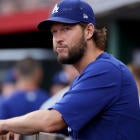
-
Scott’s Sleepers 1.0
Scott White 13 min read
-
Breakouts 1.0
Frank Stampfl 10 min read
-
Busts 1.0
Chris Towers 2 min read
-
Outfield Tiers 1.0
Scott White 1 min read
-
Shortstop Tiers 1.0
Scott White 1 min read





